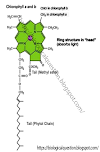Structure of Chlorophyll
Introduction of Chlorophyll
Chlorophyll is a green pigment that is found in the chloroplasts of green plants and algae. It is responsible for capturing light energy from the sun and converting it into chemical energy through the process of photosynthesis. Chlorophyll is essential for the survival of most organisms on Earth, as it is the basis for most of the planet's food chains.
There are several types of chlorophyll, including chlorophyll a and chlorophyll b, which are found in higher plants, and chlorophyll c, which is found in some algae. Each type of chlorophyll has a slightly different structure, but they all share the ability to absorb light energy and transfer it to other molecules in the photosynthetic pathway.
In addition to its role in photosynthesis, chlorophyll has also been found to have health benefits for humans. It is a powerful antioxidant that can help protect cells from damage caused by free radicals. Chlorophyll has also been used in traditional medicine to help treat a variety of conditions, including bad breath, constipation, and skin conditions.
Overall, chlorophyll is a fascinating and important pigment that plays a critical role in both the biology of plants and the health of humans.
Structure of Chlorophyll :
Chlorophyll is a pigment that is found in the chloroplasts of green plants and algae. It is responsible for capturing light energy and converting it into chemical energy through the process of photosynthesis. The structure of chlorophyll can be divided into two parts: the porphyrin ring and the phytol tail.
The porphyrin ring is a large, planar ring structure that contains four nitrogen atoms at the corners of the ring. In the center of the ring is a magnesium ion, which is responsible for absorbing light energy. The porphyrin ring is also responsible for giving chlorophyll its characteristic green color.
The phytol tail is a long hydrocarbon chain that is attached to the porphyrin ring. This tail allows chlorophyll to embed itself into the thylakoid membrane of the chloroplast, where it can capture light energy and convert it into chemical energy.
Overall, the structure of chlorophyll is essential for its function in photosynthesis, as it allows it to absorb light energy and use it to produce ATP and NADPH, which are used to power the conversion of carbon dioxide into glucose.
Diagram
Thank you for Reading the article.



.png)

.png)
0 Comments